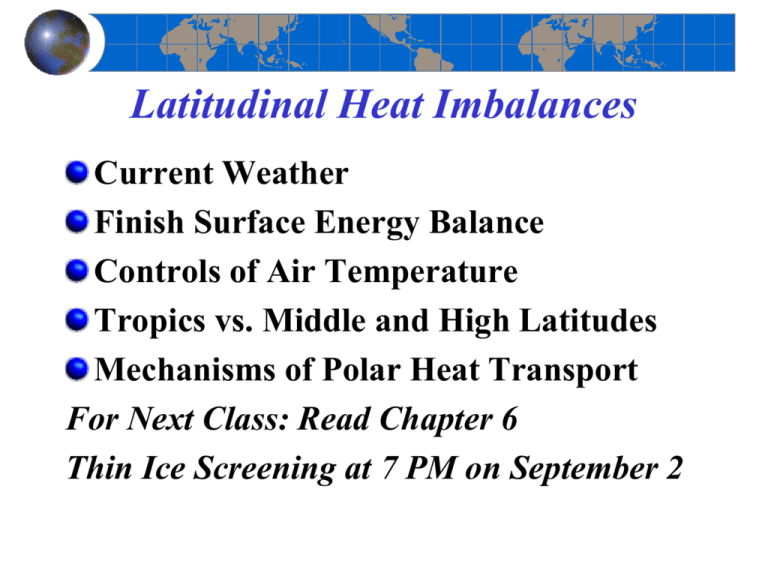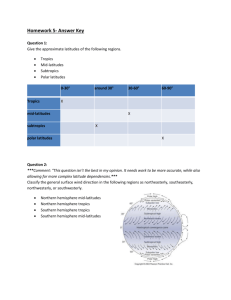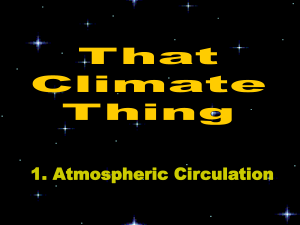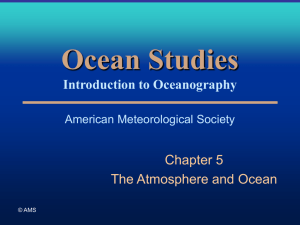06_Thermal_Response_2
advertisement

Latitudinal Heat Imbalances Current Weather Finish Surface Energy Balance Controls of Air Temperature Tropics vs. Middle and High Latitudes Mechanisms of Polar Heat Transport For Next Class: Read Chapter 6 Thin Ice Screening at 7 PM on September 2 Bowen Ratio Bowen ratio = (sensible heating)/(latent heating) High Bowen ratio implies more sensible heating than latent heating (i.e., deserts) Low Bowen ratio implies more latent heating than sensible heating (i.e., oceans or water bodies) Heat Imbalance: Atmosphere vs. Earth’s Surface © AMS 3 Simplified Surface Energy Balance NET R = +SW (insolation) –SW (reflection) +LW (infrared) –LW (infrared) Figure 4.16 Global NET Radiation Describe the spatial patterns: which areas have the highest net radiation? Why? The lowest? Why? Figure 4.17 Latitude and Temperature Figure 5.4 January Temperatures Figure 5.14 July Temperatures Figure 5.17 Global Temperature Ranges Figure 5.19 Temperature Where is the coldest location in the world likely to be in January? Why? In July? Why? Which location has the greatest annual temperature range? Why? General circulation of the atmosphere and ocean is driven by latitudinal heating imbalances (i.e. surplus in tropics and deficit in polar regions) Heating Imbalance: Tropics vs. High Latitudes Poleward heat transport brought about by • Air mass exchange • Storm systems • Ocean circulation © AMS 12 Heating Imbalance: Tropics vs. High Latitudes Heat Transport by Air Mass Exchange • Air Mass: huge volume of air covering thousands of square kilometers that is relatively uniform horizontally in temperature and humidity © AMS Properties depend largely on characteristics of source region 13 Source regions of air masses that regularly invade North America © AMS 14 Heating Imbalance: Tropics vs. High Latitudes Heat Transport by Storms • Acquisition and subsequent release of latent heat in migratory storm systems transports heat to the poles • Tropical storms and hurricanes are greater contributors to poleward heat transport than ordinary middle latitude storms © AMS 15 Blizzard of 1993 Developed in association with an extremely amplified Rossby Wave. Note the strong cold front in Honduras! Heating Imbalance: Tropics vs. High Latitudes Heat Transport by Ocean Circulation • Contributes to poleward heat transport via winddriven surface currents and the deeper thermohaline circulation © AMS Surface water that is warmer than the overlying air is a heat source for the atmosphere Surface water that is cooler than the overlying air is a heat sink for the atmosphere 18 Heating Imbalance: Tropics vs. High Latitudes Heat Transport by Ocean Circulation • Thermohaline circulation: densitydriven movement of water masses, traversing the lengths of the ocean basins © AMS Also known as the meridional overturning circulation (MOC) 19 The Gulf Stream Figure 5.10 Sea-Surface Temperatures Figure 5.11








